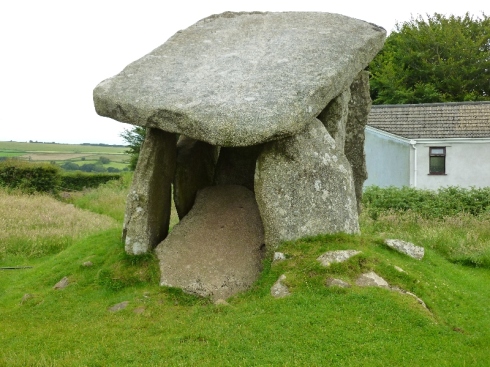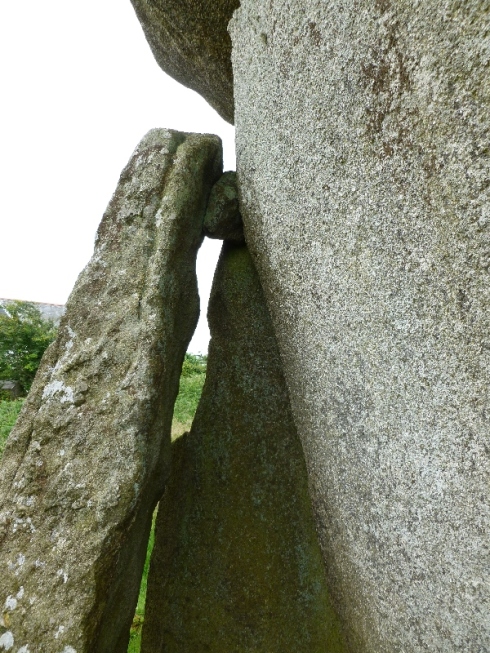
The Logan Rock on Louden Hill, Cornwall, with Rough Tor in the background
©
Elizabeth Dale
Cornwall is blessed with a long and fascinating history. Although visitors are often drawn to the county by the so called ‘Poldark effect’ many more are also seeking out our enigmatic prehistoric monuments. Elizabeth Dale investigates the hidden threat to this precious heritage.
Cornwall has some of the oldest prehistoric sites in England. The rolling landscape is dotted with hundreds of stone circles, cairns and quoits, some predating the Egyptian pyramids.
“One of the outstanding things for me about Cornwall is the huge number of stone monuments,” says Ann Preston-Jones, Historic England’s Heritage at Risk Officer for Cornwall, “We’ve got so much still standing. You can walk on Bodmin Moor and into a house that was inhabited 3000 years ago, that is just amazing.”
It is startling then to learn that more than 93% of Cornwall’s ancient monuments remain almost completely unprotected.
The Historic Environment Record, the principle source of information on archaeological sites in the UK, lists more than 13,000 prehistoric monuments in Cornwall, only 816 are scheduled. In recent years a lack of government funding has meant a slowdown in scheduling across the country. Between 2007 and 2017 only six prehistoric monuments were scheduled in Cornwall, of those just two were previously unprotected sites, the rest were updates to monuments already recorded.
“Scheduling of archaeological sites started tailing off in 2003” says Dr Sandy Gerrard who worked for the Designation Department of English Heritage for over 20 years. Part of his job involved identifying sites which needed to be protection.
According to Sandy when the Monuments Protection Programme merged with the department for Listed Buildings in 2002 scheduling essentially stopped.
“Requests for scheduling were mostly kicked into the long grass and only in exceptional circumstances were assessments carried through to fruition. . . An obvious question is does it matter that the designation department at English Heritage has turned its back on protecting archaeology, the answer must surely be yes. English Heritage has a clear duty to identify and seek to protect nationally important archaeology.”
Much of the scheduling in Cornwall was done in the early part of the 20th century and worryingly some records haven’t been updated for almost 100 years. Early scheduling relied on an archaeologist marking the spot to be designated on a map. At that time they usually thought only in terms of an isolated feature, such as an individual barrow or quoit, and didn’t considered the importance of protecting the surrounding landscape. This leaves undiscovered archaeology beneath the ground vulnerable.
To be scheduled a monument must be of national importance, clearly not all of the 13,000 ancient sites identified on the HER list would warrant that designation. It is also a discretionary process, not mandatory. However the halt in new designations means some significant sites are being left relatively defenceless and some question the message that this sends to the public about the importance of our heritage sites.
“The clear message that archaeology can be ignored is a dangerous one to send out.” Says Dr Gerrard.
Ann Preston-Jones agrees, “I’ve always thought that everyone should recognise how wonderfully important the archaeology is here and that it shouldn’t matter whether it is scheduled or not but I’ve come to realise sadly that it really does matter. Scheduling gets into people’s consciousness far more.”
This argument is borne out by events in Penwith in 2013 when an ancient standing stone near Crows-an-Wra disappeared over night. The Rissick stone, which wasn’t scheduled, was pulled up by an agricultural firm who wished to clear the field for potato planting.
Cheryl Straffon, editor of the Meyn Mamvro magazine, says that its removal highlights a very worrying situation. “How can it be that a standing stone can be simply removed or destroyed with nobody being informed or consulted? The ‘unknown’ stone at Rissick . . . was unceremoniously removed and sold on without anyone being informed.”
Ann confirmed that if the stone had been scheduled Historic England would certainly have looked into having it returned to its rightful place. “Strategically English Heritage works really hard to demonstrate the value of heritage especially in a place like Cornwall where tourism is such an important part of the economy. A lot of the tourists that come down here, certainly to West Penwith and Bodmin Moor, are here to look at the old sites.”
With only 6% of Cornwall’s prehistoric monuments protected, a population boom and a government keen on building houses the potential risk to smaller unscheduled sites is growing.
There are also some glaring omissions in the scheduling as Roy Goutte explained. Roy, an amateur archaeologist, works on Bodmin Moor with his volunteer team TimeSeekers, providing much-needed clearance work.
Last summer Roy and his team worked clearing turf away from two stones circles and uncovered a 300m long stone row at Leskernick Hill. They were shocked to discover that none of the features, most dating from the early Bronze Age, were scheduled.
“It was a great surprise to me to discover that the whole Leskernick complex was not scheduled.” Roy told me and his concerns were justified as the work got underway. “During the clearance there were signs of damage by recent metal detectorists and earlier ‘treasure seekers’ who had dug into the cairn nearest the stone row and those on Leskernick Hill itself. Throughout the settlement there are indications of damage where stones from the round houses have been lifted, there were also clear signs of [farm] vehicles damaging the stone circles and also the removing or breaking up of the now recumbent stones.”
Ann Preston-Jones agrees that the Leskernick site is unique in Cornwall and of national importance but as one of what is now a much smaller department her time is understandably taken up with the 250 scheduled sites unfortunately on the At Risk Register. She also works one day a week for the Cornwall Archaeological Unit which is part of Cornwall Council.
“Before the crash happened, when the council suddenly had to contract, until then we had quite a thriving historical environment team . . . now we’ve all now been fragmented into different departments and have less funding than we ever did have.” The Cornwall Archaeological Unit has no core funding, this means they rely solely on money designated for individual projects and therefore are unable to be proactive in their work.
Ann is clearly passionate about Cornwall’s heritage but in recent years has been working very hard with very little. “I am always, always being reactive, I don’t have time to go out and look at sites but what I do have is this list of high risk monuments and those are my priority.”
Meanwhile there are other sites arguably of national importance left unscheduled and unprotected such as the iconic Brown Willy tor or Largin Castle near to Fowey. This massive
hill fort lies in woodland not far from the A38. Built in the Iron Age Largin has triple ramparts surrounding a central enclosure 105m across. All unscheduled.
It is not only the prehistoric remains that are at risk. Many of Cornwall’s medieval crosses are not scheduled or listed either. Many of these unique artefacts are on private land and are small and potentially portable. Without the necessary protection theoretically the landowner could move and decide to take the cross with them without breaking any law.
Stuart Dow, a member of Roy’s clearance team, feels passionately about the situation and its possible consequences “I feel that it is imperative that all ancient sites are scheduled and protected by law from any disturbance or alteration. Too many have disappeared under the farmer’s plough or the tardy planners failure to care. For the sake of the generations yet to come it is this generation’s duty to safeguard all of our ancient sites.”
For more articles by Elizabeth see her website, cornishbirdblog.

















